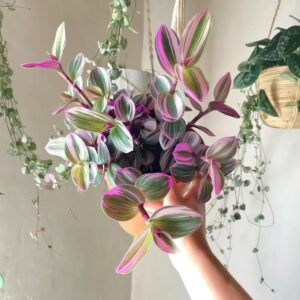Nanouk Pink, also known as Tradescantia Nanouk or Fantasy Venice, is a stunning plant renowned for its vibrant hues and delicate foliage.
In recent years, this captivating succulent has gained widespread popularity among plant enthusiasts, thanks to its unique characteristics and ease of care.

Characteristics of Nanouk Pink
Appearance and Physical Attributes
Nanouk Pink features fleshy, lance-shaped leaves that boast a mesmerizing blend of pink, purple, and green hues. Its trailing stems produce clusters of small, three-petaled flowers in shades of pink and white, adding a delightful touch of color to any space.
Growth Habit and Size
This charming succulent has a trailing growth habit, making it an excellent choice for hanging baskets or cascading over shelves and windowsills. With proper care, Nanouk Pink can reach heights of up to 12 inches and spread out several feet, creating a lush and vibrant display.
Light and Water Requirements
Nanouk Pink thrives in bright, indirect light, making it ideal for placement near a sunny window or under grow lights. However, it can also tolerate moderate shade, making it versatile for various indoor environments. When it comes to watering, allow the soil to dry out slightly between waterings to prevent root rot.
Care and Maintenance Tips
Soil and Potting Requirements
Provide Nanouk Pink with well-draining soil to prevent waterlogged conditions that can lead to root rot. A mix of cactus or succulent soil combined with perlite or sand works well to ensure proper drainage. Repotting may be necessary every year or two to refresh the soil and accommodate the plant’s growth.
Temperature and Humidity Needs
Maintain moderate temperatures between 65°F and 80°F for optimal growth, avoiding extreme cold or heat. Nanouk Pink thrives in average indoor humidity levels but appreciates a slight increase in humidity during the dry winter months. Regular misting or placing a small humidifier nearby can help maintain adequate moisture levels.
Pruning and Propagation Techniques
To encourage bushier growth and prevent legginess, regularly pinch back the growing tips of Nanouk Pink. Additionally, stem cuttings can be easily propagated in soil or water, allowing you to expand your collection or share with fellow plant enthusiasts.
For more information you can read at Do You Know About Tradescantia Nanouk Care?
Benefits of Nanouk Pink
Aesthetic Appeal and Decorative Value
Nanouk Pink’s striking foliage and delicate blooms add a touch of elegance and beauty to any indoor space. Whether displayed as a standalone specimen or incorporated into a mixed planting arrangement, this eye-catching succulent is sure to attract attention and admiration.
Air Purification and Health Benefits
Like many other houseplants, Nanouk Pink contributes to indoor air purification by removing toxins and pollutants from the surrounding environment. Its efficient photosynthesis process helps to increase oxygen levels while reducing carbon dioxide, creating a healthier and more invigorating atmosphere.
Low Maintenance and Easy to Grow
One of the most appealing aspects of Nanouk Pink is its low maintenance nature and ease of cultivation. Even novice plant enthusiasts can successfully grow and care for this resilient succulent, making it an excellent choice for busy individuals or those new to indoor gardening.
Common Issues and Troubleshooting
Pest and Disease Management
While Nanouk Pink is relatively pest and disease resistant, it may occasionally encounter issues such as spider mites or mealybugs. Inspect the plant regularly for signs of pests, and treat infestations promptly with insecticidal soap or neem oil to prevent further damage.
Common Growth Problems
Overwatering is the most common issue faced by Nanouk Pink owners, leading to root rot and fungal infections. To avoid this, allow the soil to dry out between waterings and ensure adequate drainage. Additionally, monitor for signs of wilting, yellowing leaves, or soggy soil, which may indicate overwatering.
Solutions and Remedies
If you suspect overwatering or poor drainage is causing issues, adjust your watering schedule and consider repotting the plant in a well-draining soil mix. Trim away any affected or rotting roots and allow the soil to dry out before resuming normal watering practices. With proper care and attention, Nanouk Pink can recover and thrive once again.
Conclusion
In conclusion, Nanouk Pink is a delightful and charming succulent that adds a pop of color and elegance to any indoor space. With its striking foliage, easy care requirements, and air-purifying qualities, it’s no wonder that this captivating plant has become a favorite among plant enthusiasts worldwide. Whether you’re a seasoned gardener or new to indoor plants, Nanouk Pink is sure to bring joy and beauty to your home or office environment.
FAQs about Nanouk Pink
1. Can Nanouk Pink tolerate low light conditions? Nanouk Pink prefers bright, indirect light but can tolerate moderate shade. However, it may not thrive in low light conditions and may become leggy or lose its vibrant colors.
2. How often should I water Nanouk Pink? Water Nanouk Pink thoroughly when the top inch of soil feels dry to the touch, allowing excess water to drain away. Avoid overwatering, as this can lead to root rot and other issues.
3. Is Nanouk Pink toxic to pets? While Nanouk Pink is not considered highly toxic, it’s best to keep it out of reach of pets and children to prevent accidental ingestion. Monitor pets closely around the plant, and seek veterinary attention if any signs of illness occur.
4. Can I place Nanouk Pink outdoors? Nanouk Pink is best suited for indoor environments or outdoor spaces protected from direct sunlight and harsh weather conditions. Avoid placing it in full sun, as this can scorch the leaves and cause damage.
5. How can I encourage Nanouk Pink to bloom? Nanouk Pink blooms sporadically throughout the year, typically in response to changes in light or temperature. Providing adequate sunlight, proper watering, and occasional fertilization can help encourage blo

